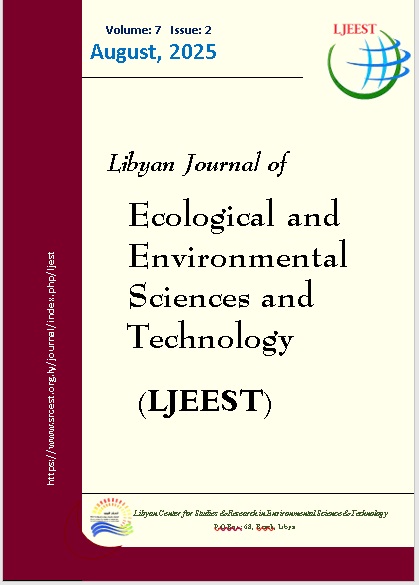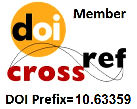Radiation Risks of Daily Coffee Consumption: Analysis of Radioactive Nuclide Concentrations in Imported Coffee Beans (Case Study: Libya)
DOI:
https://doi.org/10.63359/g4p9jq92Keywords:
Radiation risks, Coffee consumption, Radioactive elements, Effective doseAbstract
This study examines the radiation risks linked to daily coffee consumption by analyzing the presence of natural and artificial radioactive contaminants in imported coffee beans in Libya. With coffee being a widely consumed beverage, this study addresses the often-overlooked issue of radioactive contamination in food products. Samples of roasted Arabica and Robusta coffee beans from India, Brazil, Colombia, and Ethiopia were collected and analyzed using a high-purity germanium (HPGe) detector. The results revealed no detectable levels of the artificial radionuclide; however, measurable concentrations of K⁴⁰, Ra²²⁶, and Ra²²⁸ were identified. Notably, K⁴⁰ concentration levels exceeded the UNSCEAR recommended limit in several samples, Ra²²⁶ and Ra²²⁸ concentrations remained within safe limits. The estimated annual effective dose from coffee consumption for adults ranged from 17.68 to 92.57 μSv.y⁻¹. The lowest effective dose that the consumer can receive comes from Colombian coffee, while the highest dose comes from Brazilian coffee. In general, all effective doses are below the global mean for internal radiation exposure. These findings suggest that while the radioactive content in the analyzed coffee poses minimal health risks, ongoing monitoring and regulation are crucial to ensure consumer safety.
References
Abodunrin, O., Olaoye, M. A., & Okuwobi, B. A. (2024). Long-lived GammaEmitting Radionuclides in Commonly Consumed Imported Coffee Brands in Lagos and the Total Committed Effective Dose using a High Purity Germanium Detector. London Journal of Physics, 1(1). https://doi.org/10.69710/ljp.v1i1.10343
Ali, J. M., Hasan, H. M. A., & Hasan, J. M (2022). Evaluation of Radioactive Elements in some Vegetables Samples Collected from Different Regions around Al-Guba City-Libya. https://ljbs.omu.edu.ly
AL-abrdi, A. M (2023). Measurements of natural radioactivity and evaluation of radiation hazard indices in Barley Samples in Libya Markets. Libyan Journal of Basic Sciences (LJBS): 20, No: 2, P: 51-64 https://ljbs.omu.edu.ly/eISSN
AL-abrdi, A. M., Hazawi, A. A., Alsaadi, S. D., & Abdullah, R. H. (2023). Estimation of Annual Gonadal Dose Equivalent in Some Livestock Food inLibyanMarkets.https://doi.org/10.54172/mjsc.v38i2.1207
Awudu, A., Faanu, A., Darko, E., Emi-Reynolds, G., Adukpo, O., Kpeglo, D., ... & Agyeman, B. (2012). Preliminary studies on 226 Ra, 228 Ra, 228 Th and 40 K concentrations in foodstuffs consumed by inhabitants of Accra metropolitan area, Ghana. Journal of Radioanalytical and Nuclear Chemistry, 291(3), 635-641. https://doi.org/10.1007/s10967-011-1444-9
Elmasri, K., & Algretli, A. (2023). Measurement of Natural Radionuclides Concentration in Libyan Food Spices Samples. Alostath, (24). https://www.uotpa.org.ly/alostath/index.php/alostath/article/view/314
Geras' kin, S., Evseeva, T., & Oudalova, A. (2013). Effects of long-term chronic exposure to radionuclides in plant populations. Journal of Environmental Radioactivity, 121, 22-32 https://doi.org/10.1016/j.jenvrad.2012.03.007
Helgi Analytics, (2023.). Coffee consumption per capita of Libya. Helgi Library. https://www.helgilibrary.com/indicators/coffee-consumption-per-capita/libya/
ICRP, 2012. Compendium of Dose Coefficients Based on ICRP Publication 60, vol. 119 ICRP Publication Ann. ICRP 41 (Suppl.). Available at. https://www.icrp.org/docs/P%20119%20JAICRP%2041(s)%20Compendium%20of%20Dose%20Coefficients%20based%20on%20ICRP%20Publication%2060. pdf
Jibiri NN, Isinkaye MO, Bello IA, Olaniyi PG (2016). Dose assessments from the measured radioactivity in soil, rock, clay, sediment and food crop samples of an elevated radiation area in south-western Nigeria. Environ. Earth Sci. 75:107.
Kanda, J. (2013). Continuing 137 Cs release to the sea from the Fukushima Dai-ichi Nuclear Power Plant through 2012. Biogeosciences, 10(9), 6107-6113. https://doi.org/10.5194/bg-10-6107-2013, 2013.
Khandaker, M. U., Zainuddin, N. K., Bradley, D. A., Faruque, M. R. I., Almasoud, F. I., Sayyed, M. I., ... & Jojo, P. J. (2020). Radiation dose to Malaysian populace via the consumption of roasted ground and instant coffee. Radiation Physics and Chemistry, 173, 108886. https://doi.org/10.1016/j.radphyschem.2020.108886
Ramli, A. T., Apriantoro, N. H., & Wagiran, H. (2009). Assessment of radiation dose rates in the high terrestrial gamma radiation area of Selama District, Perak, Malaysia. Applied Physics Research, 1(2), 45.
.Roselli, C., Desideri, D., Rongoni, A., Saetta, D., & Feduzi, L. (2013). Radioactivity in coffee. Journal of Radioanalytical and Nuclear Chemistry, 295, 1813-1818.
Sangbok, L., Choi, D., Park, J., Lee, S., Choi, K., Seunggeon, A., ... & Jang, Y. (2021). Analysis of Gamma Radioactivity Concentration of Coffee and Investigation of Harmfulness using High Purity Germanium Detector. In Transactions of the Korean Nuclear Society Virtual Spring Meeting May (pp. 13-14).
Kanda, J. (2013). Continuing 137 Cs release to the sea from the Fukushima Dai-ichi Nuclear Power Plant through 2012. Biogeosciences, 10(9), 6107-6113. https://doi.org/10.5194/bg-10-6107-2013, 2013.
Khandaker, M. U., Zainuddin, N. K., Bradley, D. A., Faruque, M. R. I., Almasoud, F. I., Sayyed, M. I., ... & Jojo, P. J. (2020). Radiation dose to Malaysian populace via the consumption of roasted ground and instant coffee. Radiation Physics and Chemistry, 173,108886.https://doi.org/10.1016/j.radphyschem.2020.108886
Ramli, A. T., Apriantoro, N. H., & Wagiran, H. (2009). Assessment of radiation dose rates in the high terrestrial gamma radiation area of Selama District, Perak, Malaysia. Applied Physics Research, 1(2), 45.
.Roselli, C., Desideri, D., Rongoni, A., Saetta, D., & Feduzi, L. (2013). Radioactivity in coffee. Journal of Radioanalytical and Nuclear Chemistry, 295, 1813-1818.
Sangbok, L., Choi, D., Park, J., Lee, S., Choi, K., Seunggeon, A., ... & Jang, Y. (2021). Analysis of Gamma Radioactivity Concentration of Coffee and Investigation of Harmfulness using High Purity Germanium Detector. In Transactions of the Korean Nuclear Society Virtual Spring Meeting May (pp. 1314). https://doi.org/10.21608/aunj.2024.263847.1073
Sarap, N. B., Janković, M. M., Todorović, D. J., Nikolić, J. D., & Kovačević, M. S. (2014). Environmental radioactivity in southern Serbia at locations where depleted uranium was used. Archives of Industrial Hygiene and Toxicology, 65(2), 189-197. Doi 10.2478/10004-1254-65-2014-2427
United Nations Scientific Committee on the Effects of Atomic Radiation. (2000). Sources and effects of ionizing radiation: UNSCEAR 2000 Report to the General Assembly, with scientific annexes. United Nations.
United Nations Scientific Committee on the Effects of Atomic Radiation. (2010). Sources and effects of ionizing radiation, united nations scientific committee on the effects of atomic radiation (UNSCEAR) 2008 report, volume I: Report to the
Downloads
Published
Issue
Section
License
Copyright (c) 2025 Libyan Journal of Ecological & Environmental Sciences and Technology

This work is licensed under a Creative Commons Attribution-NonCommercial 4.0 International License.















